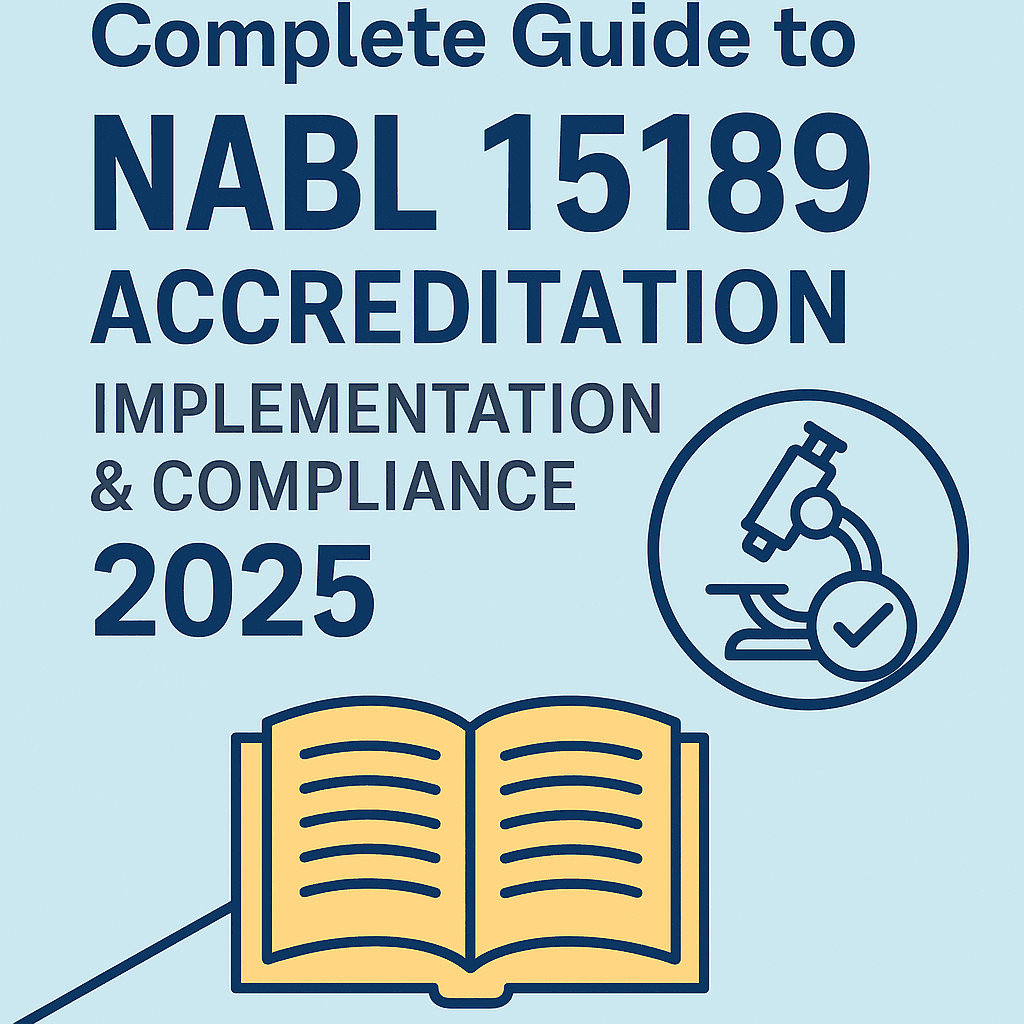A Complete Guide to NABL 15189: Accreditation, Benefits, Implementation & Compliance for Medical Laboratories in 2025

A Complete Guide to NABL 15189: Accreditation, Benefits, Implementation & Compliance for Medical Laboratories in 2025
In today’s healthcare ecosystem, accuracy, efficiency, and quality control in medical laboratories are critical. Laboratories need more than just good intentions—they require systems and standards. That’s where NABL 15189 accreditation comes in.
This guide provides a detailed breakdown of NABL 15189, including what it is, why it matters, who needs it, and a step-by-step plan to get accredited.
What is NABL 15189?
NABL 15189 refers to the accreditation provided by the National Accreditation Board for Testing and Calibration Laboratories based on ISO 15189:2022 — “Medical laboratories – Requirements for quality and competence.”
Key Features:
- Based on internationally recognized standards.
- Ensures quality and competence in medical testing.
- Focuses on patient safety, reliability, and risk mitigation.
Why is NABL 15189 Crucial for Labs?
1. International Recognition
Accredited labs are recognized under ILAC (International Laboratory Accreditation Cooperation) agreements, making your test results acceptable globally.
2. Higher Patient Confidence
With accurate test results and standardized operations, patients and doctors place more trust in your lab.
3. Mandatory for Government Tenders & Panels
Government healthcare schemes (CGHS, ECHS, Ayushman Bharat) require NABL accreditation to empanel labs.
4. Operational Excellence
Helps labs build reliable systems, reduce errors, automate workflows, and improve internal efficiency.
5. Competitive Advantage
NABL 15189 is a strong differentiator in both B2B and B2C medical diagnostics markets.
Who Should Go for NABL Accreditation?
- Pathology labs
- Microbiology and molecular diagnostic labs
- Hospital-attached laboratories
- Standalone private labs
- Academic institutions and R&D labs offering diagnostic services
Whether you’re a startup lab or an established diagnostic chain, NABL 15189 provides the roadmap to consistent quality.
Requirements for NABL 15189 Accreditation
Here are the core pillars your lab must implement:
1. Quality Management System (QMS)
Create a documented system outlining how your lab maintains quality—from sample collection to report dispatch.
2. Competence of Personnel
Each staff member must be trained and periodically evaluated for performance.
3. Proper Equipment Management
All equipment must be:
- Calibrated regularly
- Maintained with logs
- Backed with traceability to national/international standards
4. Internal Audit & Corrective Actions
Audits help identify weak links in processes and must be followed by effective corrective and preventive actions (CAPA).
5. Proficiency Testing (PT)
Labs must participate in External Quality Assessment Schemes (EQAS) and proficiency testing programs.
Step-by-Step NABL Accreditation Process
Here’s how your lab can get NABL 15189 certified:
Step 1: Conduct a Gap Assessment
Compare your lab's current practices with NABL 15189 requirements.
Step 2: Develop QMS & SOPs
- Create a Quality Manual
- Document Standard Operating Procedures (SOPs)
- Include all process flows (from pre-examination to post-examination)
Step 3: Training of Personnel
Train your team on:
- Documentation handling
- Sample processing
- Non-conformity identification
- Root cause analysis
Step 4: Implement Processes
Roll out the QMS and SOPs in daily lab operations. Start maintaining logs, calibration records, test reports, and audit findings.
Step 5: Internal Audit
Conduct an internal audit to check readiness. Address all non-conformities.
Step 6: Apply for Accreditation
Register your lab with NABL through nabl-india.org, upload required documents, and pay application fees.
Step 7: NABL Assessment
NABL assigns a team of assessors to conduct a pre-assessment visit, followed by a final assessment to evaluate compliance.
Step 8: Accreditation Grant
If your lab complies with all requirements, you’ll receive a NABL 15189 certificate valid for 2 years, with annual surveillance audits.
Common Documents Required
- Quality Manual
- SOPs for all tests and departments
- Equipment calibration and maintenance logs
- Staff qualification and training records
- Sample tracking system
- PT/EQAS participation records
- Risk assessment reports
- Internal audit & CAPA records
New Updates in ISO 15189:2022
Recent updates you need to know:
- Greater emphasis on risk-based thinking
- Integration with ISO 9001 principles
- More focus on information system security
- Clearer definition of customer satisfaction metrics
Stay up to date with NABL circulars to keep your systems compliant.
Pro Tips for a Smooth Accreditation
- Start with one department (e.g. clinical biochemistry) before expanding.
- Use Laboratory Information Management Systems (LIMS) for automation and error reduction.
- Hire a consultant if your lab is large or lacks in-house quality expertise.
- Prepare for annual surveillance audits post-accreditation to retain your status.
FAQs
Q1. How long does it take to get NABL accredited?
Answer: Typically 4–6 months from documentation to certification.
Q2. Is NABL 15189 mandatory?
Answer: Not legally mandatory, but increasingly required by government and private healthcare networks.
Q3. What’s the difference between NABL and ISO 9001?
Answer: ISO 9001 focuses on general quality management; NABL 15189 is specific to medical laboratories, emphasizing technical competence and patient safety.
Final Words
Achieving NABL 15189 is a strategic investment in your lab’s future. It enhances trust, opens new business channels, ensures international compliance, and delivers real value to patients.
Want help preparing for NABL 15189? Reach out to our experts for personalized assistance.
Tags: #NABL15189 #ISO15189 #MedicalLabAccreditation #HealthcareCompliance #LabQualityManagement #DiagnosticLabsIndia